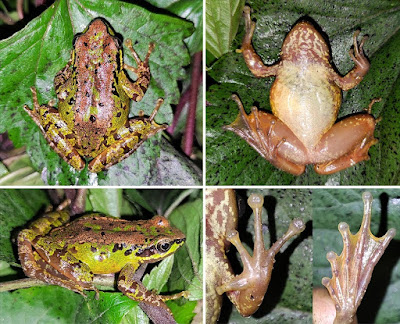 |
| Amolops ailao |
Abstract
A new species of the genus Amolops, Amolops ailao sp. nov., is described from central Yunnan, China. The new species belongs to the A. mantzorum species group. Phylogenetic analyses based on the combination of mitochondrial 16S rRNA, COI, and cytb genes revealed that the new species is the sister taxon to Amolops ottorum with strong support. Genetically, the new species differs from A. ottorum by 5.0% in cytb sequences. Morphologically, the new species can be distinguished from known congeners by the combination of the following characters: true dorsolateral folds absent, but dorsolateral folds formed by series of glands present; circummarginal groove on tip of first finger absent; body size small (males SVL 33.0–35.1 mm and female SVL 41.3 mm); HW/SVL 0.32‒0.35; UEW/SVL 0.08‒0.10; THL/SVL 0.52‒0.56; vomerine teeth absent; interorbital distance narrower than internarial distance; tympanum distinct, less than half eye diameter; supratympanic fold present, indistinct; a pair of large tubercles on sides of cloaca; tibiotarsal articulation reaching beyond anterior corner of eye; and vocal sac absent. The cladogenesis events within the A. mantzorum group rapidly occurred from Pliocene 4.23 Mya to Pleistocene 1.2 Mya, coinciding with the recent intensive uplift of the Qinghai-Tibetan Plateau since the Pliocene. Combining findings in this study with the most recent taxonomic progress, we consider that there are 20 known Amolops species in Yunnan, China, accounting for the highest proportion of amphibian diversity of Yunnan, and five of them belong to the A. mantzorum group. Among different subfauna and water systems in Yunnan, the species diversity of Amolops in northwestern Yunnan and Nu River Basin is highest.
Keywords: Amolops mantzourm, Species group, The Qinghai-Tibetan Plateau, 16S rRNA, COI, Cytb
 |
| Holotype of Amolops ailao sp. nov. in life (a and b) and in preservative (c and d). (a) dorsolateral view, (b) ventral view, (c) dorsal view, and (d) ventral view |
 |
| Dorsolateral views of male paratypes in life. (a) GXNU YU20160273; (b) GXNU YU20160274; (c) GXNU YU000003; and (d) GXNU YU000002 |
Amolops ailao sp. nov.
Diagnosis: Morphologically, Amolops ailao sp. nov. resembles members of the A. mantzorum group in the absence of true dorsolateral folds and circummarginal groove on the disc of the first finger, and further resembles A. jinjiangensis and A. shuichengicus in the presence of folds formed by incomplete series of glands along the dorsolateral junction of the body (dorsolateral glandular folds). Phylogenetically, a clade consisting of the new species, A. mantzorum, A. sangzhiensis, A. jinjiangensis, A. granulosus, A. loloensis, A. tuberodepressus, A. shuichengicus, and A. ottorum was strongly supported (Clade I; Fig. 2). Amolops ailao sp. nov. can be distinguished from its congeners by the combination of the following characters: (1) body size small (SVL 33.0–35.1 mm in males and 41.3 mm in female); (2) HW/SVL 0.32‒0.35; UEW/SVL 0.08‒0.10; THL/SVL 0.52‒0.56; (3) vomerine teeth absent; (4) tympanum distinct, less than half eye diameter; (5) supratympanic fold present, indistinct; (6) true dorsolateral folds absent, but dorsolateral glandular folds distinct; (7) absence of circummarginal groove on the disc of the first finger; (8) tibiotarsal articulation reaching beyond anterior corner of eye; (9) dorsal surface smooth with no white spines; (10) a pair of large tubercles on sides of cloaca; 11) vocal sac absent; 12) toes fully webbed except the fourth; 13) interorbital space narrower than internarial space.
Etymology: The specific epithet is named for the type locality, Ailao Mt., Xinping County, Yunnan Province, China. We suggest the English common name “Ailao Cascade Frog” and the Chinese common name “Āi Láo Tūan Wā (哀牢湍蛙)”.
 |
| Habitat at the type locality of Amolops ailao sp. nov. (a) and an adult male of Amolops ailao sp. nov. sitting on branches at the type locality (b) |
Shangjing Tang, Tao Sun, Shuo Liu, Sangdi Luo, Guohua Yu and Lina Du. 2023. A New Species of Cascade Frog (Anura: Ranidae: Amolops) from central Yunnan, China. Zoological Letters. 9; 15. DOI: 10.1186/s40851-023-00214-9
